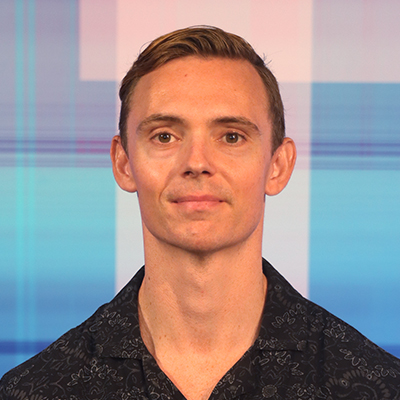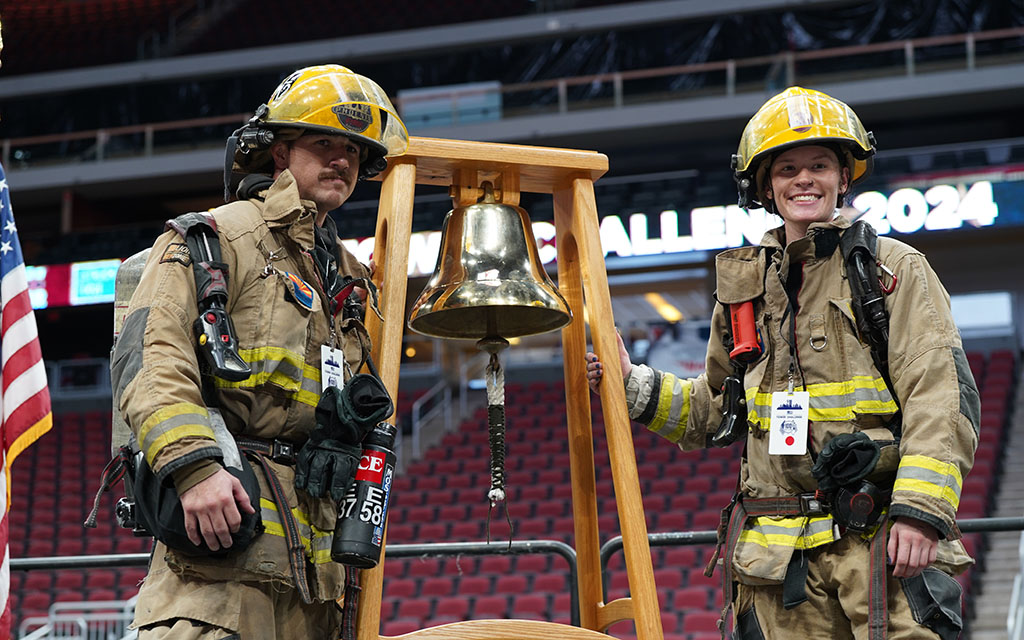GLENDALE – Everyone who’s old enough remembers where they were on Sept. 11, 2001.
Angela Harrolle was a special agent with the Department of State Diplomatic Security Service in Washington, D.C. She was in the middle of training at the Foreign Service Institute in Arlington, Virginia, when the planes struck the World Trade Center in New York City.
Class was abruptly stopped.
“They wheeled in this TV, and we were all standing around it,” Harrolle said. “And we were just overwhelmed because we had seen that the planes had hit the Twin Towers in New York. We didn’t know what to expect.”
Harrolle and her colleagues quickly learned that another plane had just hit the Pentagon four miles away from where they were training. She started running through the building to make sure everyone was evacuating from the facility.
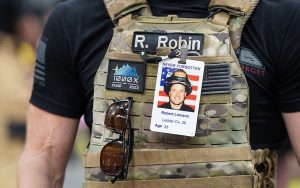
Tower Challenge participants wear lanyards honoring the first responders who made the ultimate sacrifice on 9/11. (Photo by Dean Fraulino/100 Club of Arizona)
Then she rushed to other buildings on the premises, including a daycare area for “diplo-tots,” to make sure diplomats’ young children were safe. Her mind raced.
“All that was on my mind was trying to get a phone call out to my mom or to my family to let them know that I was okay,” Harrolle said.
But her cell phone was blocked. Same with every other phone in the office. She went building to building trying to find a landline that worked. After about 20 minutes, she finally did.
“I remember calling my mom, and when she answered, it didn’t sound like her,” Harrolle said.
Her mother’s voice quivered, thinking she was about to receive the worst news imaginable.
“To know what your mom’s voice would sound like when she thinks she’s getting that call leaves an impact on you for many years,” Harrolle said. “Many, many years.”
Other first responders like Harrolle ran toward danger in the service of others on that day. In NYC, 343 firefighters and paramedics were killed. In the years since, even more have died from 9/11-related illnesses like cancer, caused by exposure to toxic chemicals and air.
The terrorist attacks on 9/11 killed 2,977 people, after two hijacked planes struck the Twin Towers in lower Manhattan, another hit the Pentagon and a fourth crashed in rural Pennsylvania following a passenger revolt. It remains the deadliest terrorist attack in U.S. history.
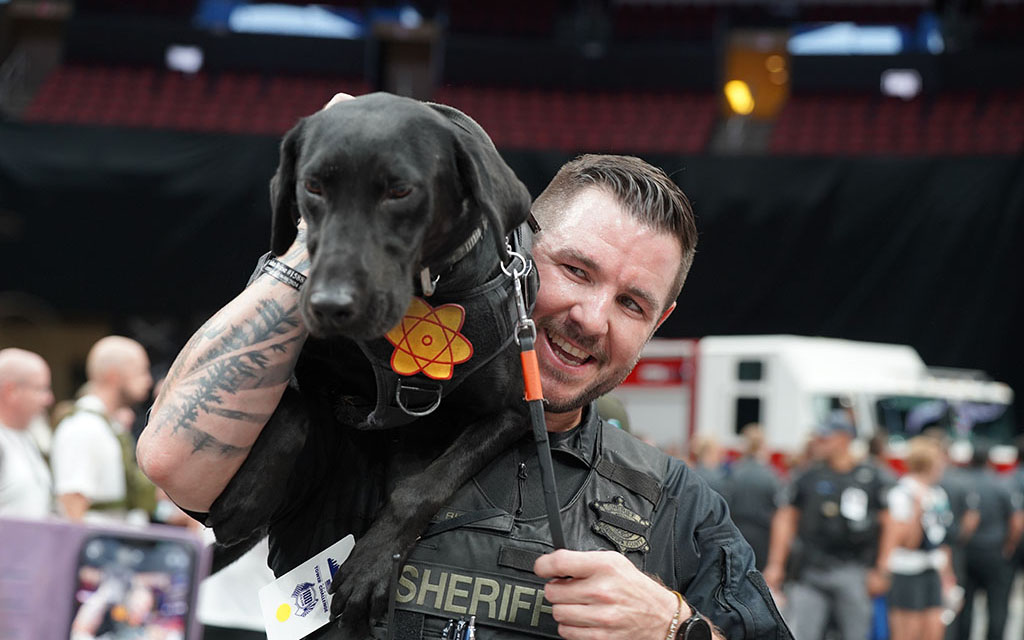
A Maricopa Sherrif’s officer and canine celebrate completing the 110-floor Tower Challenge climb. (Photo courtesy of Dean Fraulino/100 Club of Arizona)
Harrolle now works to make sure their sacrifice is not forgotten. She’s the CEO and president of 100 Club of Arizona, which supports public safety members and their families by providing financial aid, education, and ongoing support.
For the last seven years, the 100 Club and the 911 Tower Challenge Foundation have organized communal events close to the tragedy’s anniversary. Last Saturday, over a thousand first responders, friends and family met inside Desert Diamond Arena in Glendale to participate in the Tower Challenge.
“I’m here today because there were a lot of people that sacrificed their lives,” retired FBI agent Perrynn Collier said. “Regardless of the danger, they put people they didn’t even know ahead of themselves. For the love of others, they rushed to danger. And this is my way to commemorate their sacrifice and ultimately loss of life.”
The World Trade Center had 110 floors, and Saturday’s participants climbed the same distance (2,071 steps) throughout the arena. Teams of firefighters, police officers, military members, FBI agents, family and friends took off on a route that went up, down and around the lower bowl and concourse.
Photos of the heroes who died on 9/11 lined the backs of every seat nearest the aisles on each row. Some climbers stopped to look at their portraits, read their names and remember their sacrifice.
Others reflected on the lanyards they were given to wear after checking in, which also recognized a fallen hero.
“Carrying this lanyard with a fallen New York City firefighter, and then seeing all the pictures of the people who paid the ultimate sacrifice was truly surreal,” Casa Grande firefighter Andrew Griffin said. “It really made me feel emotional, because some of these people weren’t much older than I was.”
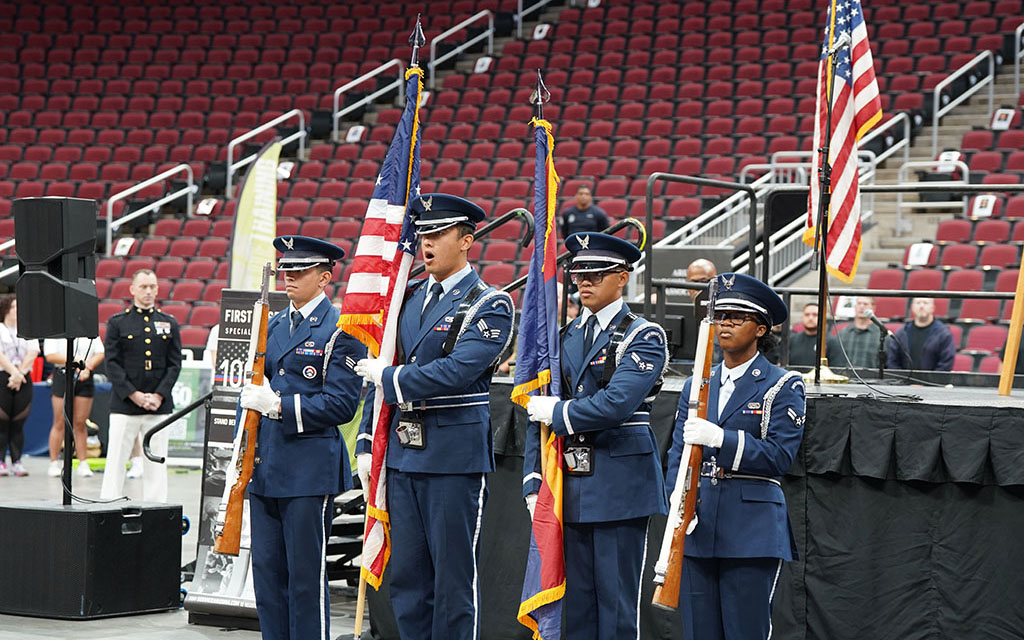
Members of the Air Force Honor Guard lead the national anthem before the start of the 2024 Tower Challenge at Desert Diamond Arena. (Photo courtesy of Dean Fraulino/100 Club of Arizona)
Griffin graduated from Williams Field High School in Gilbert in 2023 and immediately applied to become a firefighter. He passed his training and has been with Casa Grande’s department for three months. Despite being too young to witness 9/11, Griffin recognizes the significance of having the Tower Challenge ahead of the anniversary.
“We’re starting to get to the generation where many people weren’t born when 9/11 happened, myself included,” Griffin said. “Participating in this stair climb means so much, because it lets this generation remember the most ultimate sacrifice that those 343 New York City firefighters and EMTs and police officers made.”
Honoring the heroism displayed on 9/11 was only one part of the event’s purpose. It also builds community for this generation’s first responders, who might one day be in a similar position of putting themselves in harm’s way for others.
“I feel the utmost support from my family who came here to support me doing the climb,” Griffin said. “To all the police officers, to all their families, to all law enforcement, anybody who came here to do the climb. It gives me chills.”

100 Club of Arizona CEO and President Angela Harrolle, left, is Arizona’s Tower Challenge organizer for the past seven years. (Photo courtesy of Dean Fraulino/100 Club of Arizona)
One of the first climbers to finish was Collier, even though it was his second workout of the morning. The former agent woke up at 4 a.m. to bike 20 miles right before the event.
His strong performance was no accident. He began training months ago when he received the event invitation. It was his way of paying his respect.
“Every day, I ran up and down the stairs at work in preparation for this day,” Collier said, “because I wanted to be able to run up the stairs with the same energy that those first responders did. They didn’t say, ‘Oh, I need a break.’ They gave it their all to help people who needed help.
“They ran. They didn’t stop.”
Like Harrolle, 9/11 changed Collier’s life. He had been in the force for five years, working in the FBI’s Albuquerque, New Mexico division when the attacks happened. Collier watched the news coverage from his department’s electronics bay.
“You just had that sick feeling in your stomach,” Collier said. “Because you’re just watching this terrorist event and tragedy unfold before your eyes. And there’s nothing you can do about it.”
Except he did do something about it. After the attack, Collier switched from the criminal unit to counterintelligence and terrorism.
“I just wanted to be in the fight,” Collier said.

Firefighters and Arizona Department of Corrections’ Designated Armed Response Team rest before climbing back up the stairs in Desert Diamond Arena. (Photo courtesy of Dean Fraulino/100 Club of Arizona)
He was a national security investigator for nearly a decade, including five years in Guam. Collier dedicated another nine years to investigating complex financial crimes before retiring from the FBI’s Phoenix section in 2018.
“When I was looking at becoming an FBI agent,” Collier said, “I wanted to stop bank robbers, drug dealers and all those things. But after 9/11, I had a new perspective on the importance of our counterintelligence mission.”
Wednesday marks the 23-year anniversary of 9/11. Nearly three thousand people were killed, but their legacies live on. Events like the Tower Challenge help keep it that way.
The 100 Club held a second Tower Challenge Wednesday morning in Flagstaff, inside Northern Arizona University’s Skydome.
Harrolle may no longer be a diplomatic security agent, but she is still running around to make sure no one ever gets left behind.
“When 9/11 happens, obviously we get very consumed with these wonderful tribute stair climbs that we do throughout the state,” Harrolle said. “But at the same time, it gives me gratitude, for my family, for those that are still active in serving and then, of course, honoring those that have fallen in the line of duty. Not only on 9/11 but in our community every day.”
